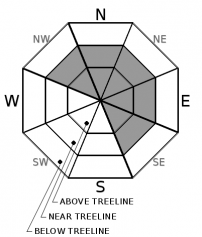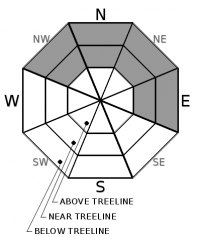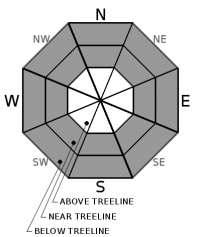| Sunday | Sunday Night | Monday | |
|---|---|---|---|
| Weather: | Mostly cloudy. Snow and rain changing to all snow by mid-morning. Scattered snow showers in the afternoon. Snow levels 7000-7500 feet early then falling below 7000 feet. Chance of precipitation is 100%. | Partly cloudy. Snow levels below 7000 feet. Chance of precipitation is 0%. | Partly cloudy. Snow levels below 7000 feet. Chance of precipitation is 0%. |
| Temperatures: | 33 to 38 deg. F. | 21 to 26 deg. F. | 36 to 41 deg. F. |
| Mid Slope Winds: | Southwest 15 to 25 mph with gusts to 40 mph. | West around 15 mph in the evening becoming light. | West winds around 10 mph. |
| Expected snowfall: | 70% probability of 1 to 3 inches. 30% probability of 3 to 5 inches. | SWE = 0.15-0.40 inch. | No accumulation. | SWE = none. | No accumulation. | SWE = none. |
| Sunday | Sunday Night | Monday | |
|---|---|---|---|
| Weather: | Mostly cloudy. Snow in the morning, then scattered snow showers in the afternoon. Snow levels 7000-7500 feet early then falling below 7000 feet. Chance of precipitation is 100%. | Partly cloudy. Snow levels below 7000 feet. Chance of precipitation is 0%. | Partly cloudy. Snow levels below 7000 feet. Chance of precipitation is 0%. |
| Temperatures: | 27 to 33 deg. F. | 19 to 24 deg. F. | 31 to 37 deg. F. |
| Ridge Top Winds: | Southwest 30 to 50 mph becoming west 20 to 30 mph in the afternoon. Gusts up to 65 mph. | West 15 to 25 mph. Gusts to 50 mph in the evening. | West 15 to 25 mph with gusts to 40 mph. |
| Expected snowfall: | 70% probability of 2 to 4 inches. 30% probability of 4 to 8 inches. | SWE = 0.25-0.50 inch. | No accumulation. | SWE = none. | No accumulation. | SWE = none. |




























